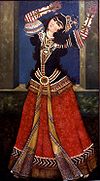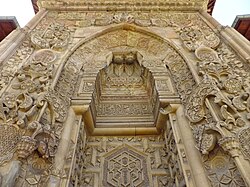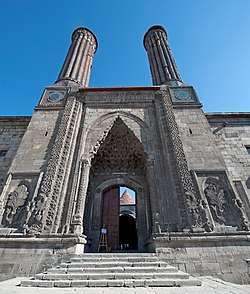
Back عمارة سلجوقية Arabic Seldschukische Architektur German Arquitectura selyúcida Spanish معماری سلجوقی Persian Architettura selgiuchide Italian Seltsjoekse architectuur Dutch Seljuk architecture SIMPLE Selçuklu mimarisi Turkish Сельджуцька архітектура Ukrainian
From top to bottom: Dome of Taj al-Mulk in the Jameh Mosque of Isfahan (1088–1089); Great Mosque of Divriği (1228–1229); and Çifte Minareli Medrese in Erzurum (c. 1250) | |
| Years active | c. 11th–14th centuries |
|---|---|
| Part of a series on the |
| Culture of Iran |
|---|
 |
|
|
| Part of a series on the |
| Culture of Turkey |
|---|
 |
| Languages |
| Mythology and folklore |
| Cuisine |
| Festivals |
| Religion |
| Art |
| Literature |
Seljuk architecture comprises the building traditions that developed under the Seljuk dynasty, when it ruled most of the Middle East and Anatolia during the 11th to 13th centuries. The Great Seljuk Empire (11th-12th centuries) contributed significantly to the architecture of Iran and surrounding regions, introducing innovations such as the symmetrical four-iwan layout and the first widespread creation of state-sponsored madrasas. Their buildings were generally constructed in brick, with decoration created using brickwork, tiles, and carved stucco.
After the 11th century the Seljuks of Anatolia emerged from the Great Seljuk Empire, along with various local dynasties, developing their own architecture. Anatolian Seljuk architecture was more eclectic and was influenced by multiple traditions including Armenian, Byzantine, Iranian, and Syrian architecture. Unlike earlier Seljuk architecture to the east, their buildings were generally constructed in stone and featured significant stone-carved decoration as well as tile decoration. While the Seljuk Sultanate declined and ended in the late 13th century, architecture continued to flourish and diversify under the smaller Beylik states in Anatolia, which included the early Ottomans.
© MMXXIII Rich X Search. We shall prevail. All rights reserved. Rich X Search


